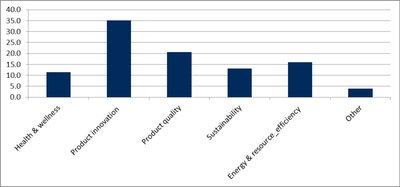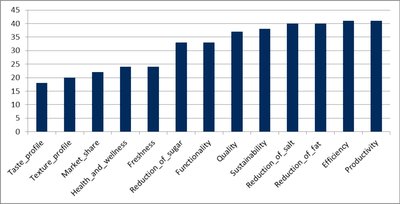What ‘foodies’ think about when investing in new technology
It is good to know that the food industry still considers quality improvements and new product development to be the main objectives when investing in new technology.
A recent Leatherhead Food Research survey in the UK asked the food and beverage industry what objectives are currently the most important when considering investment in new technology. And, despite big moves within the industry to improve sustainability and resource efficiency, 55% of respondents said the primary technology innovations needed remain focused on the product - either to deliver better quality or new products.
‘Health and wellness’ was considered as less of a priority, maybe indicating a tide of change in the focus of development teams for the coming years. This also suggests that ‘health and wellness’ is no longer the domain of the innovators but is a mainstream trend that is considered the core of any development activity since it is a still a priority agenda item across the industry.
However, when asked to consider a range of issues or themes and whether an emerging technology was the only way of achieving a step change in that area, an interesting picture emerges. When asked “which of these objectives are currently the most important when considering investment in new technology?”, “product innovation” was the clear winner. Some distance behind, in second place, was “product quality” followed by “energy and resource efficiency”.

Necessity is the mother of invention so it is important to identify where emerging technologies could be most effectively implemented to achieve that all important step change. Two main themes emerged – ‘efficiency, productivity and sustainability’ and ‘salt and fat reduction’ (Figure 2). These groupings suggest that it is generally believed that ‘green’ agendas cannot be met by the current manufacturing platforms and that the reductions in salt and fat that are possible by existing strategies are at their maximum. This echoes research conducted by Leatherhead Food Research earlier in 2012 that suggested that maximum salt reductions had been achieved within the current landscape. With ever-challenging targets such as salt reduction, it is possible that the industry will have to look at alternatives, such as nanoparticles, to achieve new levels of functionality and delivery.

The implementation of new and emerging technology is not thought to be key in further improvements to taste texture and market share - the product-centred and market-driven innovations. Yet product-centred objectives were at the heart of investment policy.
Around 60% felt that new and emerging technology would be key in the successful delivery of strategic objectives compared to existing technology; only 4% felt this would not be the case. Putting it into context of whether the greatest financial gains would be made from renovation or innovation, the population was evenly split with only 2% difference reflected between the opinions, interestingly falling in favour of renovation. It could be considered that the reasons behind this reflect the need for speed to market and return on investments; two-thirds requiring a product to market within two years and 87% needing to launch within three years. The return on investment would need to be realised within three years by 62%.
To achieve success with a fledgling technology, less than 10% considered that their exclusive use was important with 36% rating sole rights as very or extremely important.
In summary, the survey showed that ‘product’ centred innovations outweighed ‘greener’ agendas for investment in emerging technology, yet the same population conceded that new technology was more important in achieving the step change required on those issues. While emerging technologies were seen as being key to meeting strategic objectives - often the greener agenda - opinions were generally split as to whether greatest commercial gains would be from new or existing technologies; and with an expectation of product launches and return on investment coming within two to three years, it is easy to see why renovation is seen as the easier option.
Extending beyond the scope of the survey a little and considering the wider context of the questions, it may be fair to suggest that key issues such as fat and salt reduction are at the limit of the capability when considering existing technology. Health and wellness is being seen as a lower priority in terms of new technology, or that legislation has stifled the appetite for innovation in these areas. It is more likely, however, that salt and fat reduction are actually no longer considered part of the ‘health and wellness’ agenda but more of a more generic continuous improvement activity. Wider objectives such as ‘sustainability’ and energy efficiency may also be considered ‘out of scope’ for many NPD and R&D teams, possibly even unattainable even though the need is recognised to achieve the shift into next-generation ‘greener’ technology.
The markets (and marketing investment) are still driven by product innovation and quality, which is achievable through incremental improvement and renovation of existing technology. Such investment is much lower risk, and can achieve the required product launch and ROI expectations. With the need for exclusivity also being considered of importance to retain competitive advantage, this allows for progress and its associated knowledge to be retained in-house.
The great bottle battle - Coke vs Pepsi
Coke took Pepsi to court in Australia, alleging that the release of Pepsi's glass...
COAG report rejects container deposit scheme
The highly contentious container deposit scheme (CDS) has been rejected by a COAG report as being...
Everyone who is anyone in the food industry will be exhibiting at AUSPACK 2015
With AUSPACK less than three months away the expansive line-up of multinational as well as...














